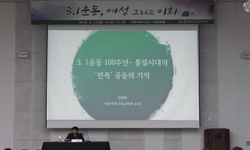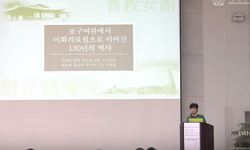본 논문의 목적은 초창기 한국교회 새벽기도회의 형성화되는 과정과 새벽기도회가 한국교회와 한국사회에 어떠한 영향을 미쳤는가에 대하여 초점을 맞추어 진행하였다. 본 논문에서는 한...
http://chineseinput.net/에서 pinyin(병음)방식으로 중국어를 변환할 수 있습니다.
변환된 중국어를 복사하여 사용하시면 됩니다.
- 中文 을 입력하시려면 zhongwen을 입력하시고 space를누르시면됩니다.
- 北京 을 입력하시려면 beijing을 입력하시고 space를 누르시면 됩니다.
https://www.riss.kr/link?id=T11585332
- 저자
-
발행사항
서울 : 연세대학교 연합신학대학원, 2009
-
학위논문사항
학위논문(석사) -- 연세대학교 연합신학대학원 , 교회사전공 , 2009. 2
-
발행연도
2009
-
작성언어
한국어
- 주제어
-
발행국(도시)
서울
-
기타서명
(The) early-morning daily prayer meetings in Korean churches
-
형태사항
v, 116장 ; 26 cm
-
일반주기명
지도교수: 이양호
- 소장기관
-
0
상세조회 -
0
다운로드
부가정보
국문 초록 (Abstract)
본 논문의 목적은 초창기 한국교회 새벽기도회의 형성화되는 과정과 새벽기도회가 한국교회와 한국사회에 어떠한 영향을 미쳤는가에 대하여 초점을 맞추어 진행하였다. 본 논문에서는 한국의 새벽기도회에 대한 내용을 다루기 전에 새벽기도에 대하여 역사적 근거로 초대 교회의 새벽기도 흔적과 중세 수도원에서의 새벽기도에 대하여 고찰하고 종교개혁과 부흥회에 대하여 루터와 칼빈 그리고 웨슬리를 통하여 그들이 얼마나 새벽기도를 중요하게 생각하는지 그리고 그들의 삶에 어떠한 영향을 미쳤는지에 대하여 설명하였다. 초창기 한국교회의 새벽기도회를 이해하기 위해서는 19세기의 조선의 시대적 상황과 선교에 대한 이해가 필요하다. 그 가운데서도 정치, 사회, 문화, 종교를 통하여 외적인 상황들과 내적인 상황들 그리고 유교, 불교, 도교 등 그 당시의 종교들 속에서 한국 개신교가 종교적으로 뿌리를 내릴 수 있었던 원동력이 바로 새벽기도회에 있음을 알 수 있다. 새벽기도회를 통하여 자신의 잘못을 뉘우치고 회개하며 나라를 위하여 기도함으로써 개인의 윤리적인 문제 뿐 만 아니라 사회전체를 변화 시킬 수 있는 역할을 감당 하였기 때문이다. 한국 교회의 최초의 새벽기도회에 대하여 1898년 2월 강진 교회 사경회에서 31명이 참석한 가운데 최초로 시작되었다고 교회사에 기록되어 있으며 이때의 새벽기도회는 초보적 형태로 시작되었다. 그리고 새벽기도회는 1901년 황해도 사경회와 다른 사경회에서 간헐적으로 진행되다가 1903년 평양 장대현 교회 사경회에 새벽기도회가 정식적으로 순서에 포함 되었다. 그리고 1905년의 이화학당에서의 학생들이 나라를 사랑하는 마음으로 자발적으로 새벽기도회를 참석하였고 공주회(King's Daughters)나 선교회(Missionary Society)를 통해서 지속적으로 기도회를 진행하였다는 것을 알 수 있다. 그리고 이러한 새벽기도는 원산과 평양이라는 지역을 통해서 점차 활성화 되었고, 1907년 길선주 목사의 경우 새벽기도회를 당회에 통과시켜 교회 안에서 새로운 예배 형태로 만들었다. 또한 김익두 목사(1874~1950)는 새벽기도회를 사경회나 부흥회의 일정한 틀로 만들었고, 이용도 목사(1901~1933)는 일정한 원칙과 질서를 무시하고 즉흥적인 감(感)에 의한 부흥회와 새벽기도회를 인도함으로 새로운 시도를 하였음을 알 수 있다. 또한 계시와 응답을 통한 새벽기도회로 김종우(1883~1940)와 신석구(1875~1950)를 통한 초창기 한국교회의 새벽기도 형성되는 과정들과 특징들을 살펴 볼 수 있다. 이러한 초창기 한국 교회의 새벽기도회는 몇 가지 중요한 특징들을 가지고 있다. 첫 번째로 어려운 현실 속에서 기독교인들은 자신을 위한 기도가 아니라 조선의 시대적 상황을 통감하고 나라를 위해서 기도했다는 것이다. 두 번째는 선교사들에 의한 강제적으로 진행한 것이 아니라 자발적으로 교회에 모여서 기도하였다. 바로 평신도들이 자원하여 참여하는 새벽기도회로 발전 시켰다는 것이다. 세 번째로 기독교가 들어오기 전에 죄로 인식하지 못하였던 것들을 바로잡고 자신의 모습을 바라보면서 회개 하면서 새로운 윤리의식을 통하여 개인적인 중생체험과 성결의 체험은 기독교가 사회윤리 형성의 밑거름이 되어 한국 기독교의 정신적 근거가 된 새벽기도회로 진행되었다. 넷째로는 모든 개신교가 참여하는 에큐메니컬적인 새벽기도회로 진행되었다. 선교사들과 한국의 교인들 사이에 좋지 않았던 감정도 새벽기도회를 통하여 하나의 마음으로 연합 할 수 있었으며, 서로 다른 교파들을 새벽기도회를 통하여 초월할 수 있었다. 마지막으로 새벽기도회는 한국적 문화 전통 속에서 형성된 신앙 양태로써 기독교를 서구적인 것이 아닌 한국적인 것으로 받아들여, 민족의 심성 속에 그 뿌리를 내리도록 계기를 마련하여 주었다. 한국의 새벽기도회는 서양이 기독교에서는 물론 한국을 제외한 동양 기독교에서도 찾아 볼 수 없는 한국 교회의 독특한 집회형태로 발생, 발전하여 토착화된 기독교 신앙의 한 유형을 보여주고 있다. 이러한 새벽기도회는 이제는 모든 한국의 개신교에서 일정한 예배의 형태로 진행되고 있음을 알 수 있다.
다국어 초록 (Multilingual Abstract)
The purpose of this thesis is to discuss the establishment of early-morning daily prayer meetings (EMDPM) in Korean churches and the impact of the EMDPM on the Korean churches as well as on the Korean societies. Before studying about the EMDPM, the th...
The purpose of this thesis is to discuss the establishment of early-morning daily prayer meetings (EMDPM) in Korean churches and the impact of the EMDPM on the Korean churches as well as on the Korean societies. Before studying about the EMDPM, the thesis attempts to find a trace of EMDPM in the 1st century Jerusalem church as well as in middle age religious houses. Moreover, the thesis will discuss that, through the religious reformation and revivals, Luther, Calvin and Wesley highly valued the EMDPM, and how EMDPM itself influenced their personal lives. In order to understand the EMDPM of early Korean churches, it is necessary to have a better understanding of the Korean social status in the 19th century, i.e., Chosun dynasty, as well as the ministry at the time in Korea. In particular, it is important to understand that, among the outer aspect, which includes politics, society, culture, and religion, and the inner aspect, as well as religions such as Confucianism, Buddhism, Taoism which were present at the time in Korea, Korean Christianity was able to establish itself in Korea was in fact due to the EMDPM. Through the EMDPM, one was able to repent, and to pray for the country, which then enabled not only to reform the personal moral change but also have an impact in changing the whole Korean society. It is recorded that the very first EMDPM took place at one of the bible studies at Kang-jin church in February of 1898 in which 31 people attended. After this first meeting, EMDPM were held occasionally in Hwang-hae province bible studies in 1901. In 1903, Pyung-yang Jang dae-hyun church finally started to include EMDPM as one of the formal programs. In 1905, students at Ehwa University started to attend EMDPM voluntarily, in particular, through King's Daughters and Missionary Society programs. EMDPM started to spread in the regions based on Won-san city and Pyung-yang city. In 1907, Rev. Gil sun-ju passed the law approving EMDPM in the elders' meeting in his church. Moreover, Rev. Kim Ick-du (1874~1950) established EMDPM as the Revival worship service, while Rev. Lee Yong-do (1901~1933) attempted to break the formality and tried to depend more on the holy spirit in leading the EMDP. Rev. Kim Jong-woo (1883~1940) and Shin Suk-koo (1875~1950) tried to establish EMDPM through prophecies and responses.These EMDPM in the early Korean churches in fact reveal several important traits. Firstly, these Christians attempted to pray for the country rather than for personal needs especially when they were facing difficult situation. Secondly, EMDPM were never forced by missionaries, instead, were held voluntarily. That is, EMDPM were established with a bottom-up approach rather than a top-down approach. Thirdly, personal re-born process in fact formed a basis for Korean Christianity which then led to EMDPM. Fourth of all, most Korean Christians participated in EMDPM regardless of their denominations. This was especially helpful in uniting foreign missionaries and Korean Christians, and helped to unite different denominations in Korean churches. Lastly, EMDPM helped Koreans to adopt the western Christianity in such a way that would fit the best for Koreans. In particular, the Korean style EMDPM introduced a completely new format of worship which was unseen in any other countries except Korea. These days, EMDPM is one of the most important parts of Korean Christianity.









